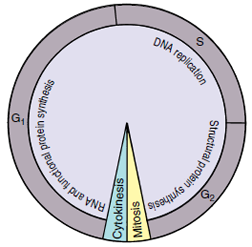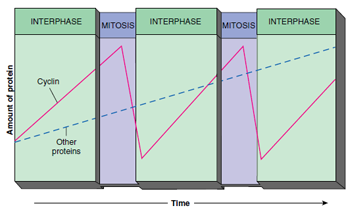Cell Cycle
Cell Cycle
Cycles are conspicuous attributes of
life. The descent of a species through
time is in a very real sense a sequence
of life cycles. Similarly, cells undergo
cycles of growth and replication as
they repeatedly divide. A cell cycle is a
mitosis-to-mitosis cycle, that is, the
interval between one cell generation
and the next (Figure 3-25).
Actual nuclear division occupies only about 5% to 10% of the cell cycle; the rest of the cell’s time is spent in interphase, the stage between nuclear divisions. For many years it was thought that interphase was a period of rest, because nuclei appeared inactive when observed by ordinary light microscopy. In the early 1950s new techniques for revealing DNA replication in nuclei were introduced at the same time that biologists came to appreciate fully the significance of DNA as the genetic material. It was then discovered that DNA replication occurred during the interphase stage. Further studies revealed that many other protein and nucleic acid components essential to normal cell growth and division were synthesized during the seemingly quiescent interphase period.
Replication of DNA occurs during a phase called the S period (period of synthesis). In mammalian cells in tissue culture, S period lasts about six of the 18 to 24 hours required to complete one cell cycle. In this period both strands of DNA must replicate; new complementary partners are synthesized for both strands so that two identical molecules are produced from the original strand.
The S period is preceded and succeeded by G1 and G2 periods, respectively (G stands for “gap”), during which no DNA synthesis is occurring. For most cells, G1 is an important preparatory stage for the replication of DNA that follows. During G1, transfer RNA, ribosomes, messenger RNA, and several enzymes are synthesized. During G2, spindle and aster proteins are synthesized in preparation for chromosome separation during mitosis. G1 is typically of longer duration than G2, although there is much variation in different cell types. Embryonic cells divide very rapidly because there is no cell growth between divisions, only subdivision of mass. DNA synthesis may proceed a hundred times more rapidly in embryonic cells than in adult cells, and the G1 period is very shortened. As an organism develops, the cycle of most of its cells lengthens, and many cells may be arrested for long periods in G1 and enter a nonproliferative or quiescent phase called G0. Neurons, for example, divide no further and are essentially in a permanent G0.
Recent results have yielded much information on the exquisite regulation of events in cell cycles. Transitions during cell cycles are mediated by cyclindependent kinases (cdk’s) and activating subunits of cdk’s called cyclins. Kinases are enzymes that add phosphate groups to other proteins to activate or inactivate them, and kinases themselves may require activation. Cdk’s become active only when they are bound with the appropriate cyclin, and cyclins are synthesized and degraded during cell cycle (Figure 3-26). Mechanisms involved in cdk regulation of cell cycles are mostly not known.
 |
| Figure 3-25 Cell cycle, showing relative duration of recognized periods. S, G1, and G2 are periods within interphase; S, synthesis of DNA; G1, presynthetic period; G2, postsynthetic period. Actual duration of the cycle and the different periods varies considerably in different cell types. After mitosis and cytokinesis the cell may go into an arrested, quiescent stage known as G0. |
Actual nuclear division occupies only about 5% to 10% of the cell cycle; the rest of the cell’s time is spent in interphase, the stage between nuclear divisions. For many years it was thought that interphase was a period of rest, because nuclei appeared inactive when observed by ordinary light microscopy. In the early 1950s new techniques for revealing DNA replication in nuclei were introduced at the same time that biologists came to appreciate fully the significance of DNA as the genetic material. It was then discovered that DNA replication occurred during the interphase stage. Further studies revealed that many other protein and nucleic acid components essential to normal cell growth and division were synthesized during the seemingly quiescent interphase period.
Replication of DNA occurs during a phase called the S period (period of synthesis). In mammalian cells in tissue culture, S period lasts about six of the 18 to 24 hours required to complete one cell cycle. In this period both strands of DNA must replicate; new complementary partners are synthesized for both strands so that two identical molecules are produced from the original strand.
The S period is preceded and succeeded by G1 and G2 periods, respectively (G stands for “gap”), during which no DNA synthesis is occurring. For most cells, G1 is an important preparatory stage for the replication of DNA that follows. During G1, transfer RNA, ribosomes, messenger RNA, and several enzymes are synthesized. During G2, spindle and aster proteins are synthesized in preparation for chromosome separation during mitosis. G1 is typically of longer duration than G2, although there is much variation in different cell types. Embryonic cells divide very rapidly because there is no cell growth between divisions, only subdivision of mass. DNA synthesis may proceed a hundred times more rapidly in embryonic cells than in adult cells, and the G1 period is very shortened. As an organism develops, the cycle of most of its cells lengthens, and many cells may be arrested for long periods in G1 and enter a nonproliferative or quiescent phase called G0. Neurons, for example, divide no further and are essentially in a permanent G0.
 |
| Figure 3-26 Variations in the level of cyclin in dividing cells of early sea urchin embryos. Cyclin binds with its cyclin- dependent kinase to activate the enzyme. |
Recent results have yielded much information on the exquisite regulation of events in cell cycles. Transitions during cell cycles are mediated by cyclindependent kinases (cdk’s) and activating subunits of cdk’s called cyclins. Kinases are enzymes that add phosphate groups to other proteins to activate or inactivate them, and kinases themselves may require activation. Cdk’s become active only when they are bound with the appropriate cyclin, and cyclins are synthesized and degraded during cell cycle (Figure 3-26). Mechanisms involved in cdk regulation of cell cycles are mostly not known.




